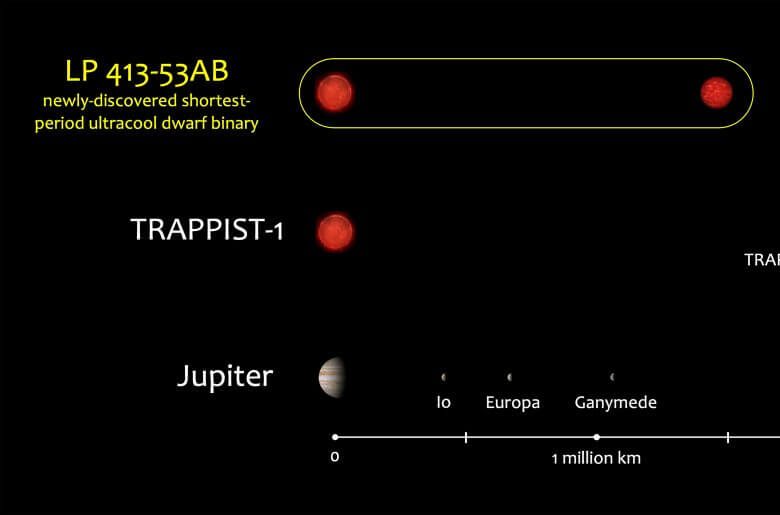【▲ Comparing the LP 413-53AB system (upper), the TRAPPIST-1 system (middle), and the Jupiter system (lower). The distance between the two ultracold dwarfs that make up LP 413-53AB is less than the distance from Jupiter to its moon Callisto (Credit: Adam Burgasser/University of California San Diego)]
A research team headed by Chih-Chun Hsu, a postdoctoral researcher at Northwestern University, has discovered a new binary star consisting of two “ultracold dwarf” stars, which are small and have low temperatures. Presented at the 241st meeting.
Ultracool Dwarf Stars are red dwarf stars with an effective temperature of less than 3000 Kelvin (about 2730 degrees Celsius), close to the lower limits of stellar size and mass, and shine mainly in infrared wavelengths. The star “TRAPPIST-1”, where seven extrasolar planets have been found so far, is also counted as one of the ultracold dwarfs.
What was reported this time is the binary star LP 413-53AB in the direction of Taurus. As mentioned above, the binary is believed to be two ultracold dwarfs orbiting each other. Two stars are 0.01 AU(※1)They are only a few degrees apart, and their orbital periods (or “one year” in other words) are as short as 20.5 hours.
*1…1 astronomical unit (au) = approximately 150 million km, derived from the average distance from the sun to the earth.
According to Adam Burgasser, a professor at the University of California, San Diego, who participated in the study, since the orbital period of many binary stars is on the order of years, measurements are taken every few months and the data are analyzed after a certain period of time. increase.However, the observed data of LP 413-53AB changes every few minutes, and the spectral line(※2)It is said that it was possible to observe the shift in “real time”.
*2…A collective name for absorption lines and emission lines that appear in the spectrum (intensity of each wavelength of electromagnetic waves).
![[▲ The current size (red) of the two ultracold dwarfs that make up LP 413-53AB and the estimated size (dotted line) around 1 million years after their formation (Credit: Adam Burgasser/University of California San Diego)]](https://sorae.info/wp-content/uploads/2023/01/ultracool-dwarf-binary-LP41353AB.jpg)
[▲ The current size (red) of the two ultracold dwarfs that make up LP 413-53AB and the estimated size (dotted line) around 1 million years after their formation (Credit: Adam Burgasser/University of California San Diego)]
LP 413-53AB is billions of years old, and it is believed that the size of the star soon after its birth was larger than it is now. “It’s amazing,” Hsu said of the distance between LP 413-53AB, which is only about 1 percent of the distance from the Sun to Earth. He points out that the stars would have overlapped. The researchers speculate that the two stars that make up LP 413-53AB may have approached each other in the course of their evolution, or they may have approached each other after the now-missing third star was ejected from the system. I’m here.
Also, in LP 413-53AB, the habitable zone happens to overlap the orbit of the binary star, so it is said that there is no planet in the habitable zone. Ultracold dwarfs are also estimated to make up 15 percent of the stars in the solar system’s vicinity, but if close binary stars, such as LP 413-53AB, are common among ultracold dwarfs, few habitable planets would be found. Hsu commented that it might not be. To investigate these scenarios for ultracold dwarf binaries, the research team hopes to identify more similar binaries.
Source
- Image Credit: Adam Burgasser/University of California San Diego
- Northwestern Now – Ultracool dwarf binary stars break records
Sentence/sorae editorial department


